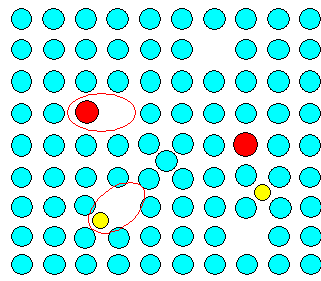 |
Besides intrinsic point defects,
crystals always contain extrinsic point defects - impurity atoms on
substitutional or interstitial sites. |
|
|
|
 |
The concentration cF of
extrinsic point defects is pretty much constant - it cannot be in equilibrium.
What is going on in a macroscopic way is given by the phase diagram of crystal
plus impurity atoms |
|
|
 |
If we discuss extrinsic point defects (in
contrast to alloys), we discuss small cF values.
Nevertheless, cF might be much larger than
cC, the equilibrium concentration of vacancies;
especially at low temperatures. |
|
|
|
|
|
|
 |
The concentration
cC of impurity atom - vacancy complexes is easy to
calculate, the decisive parameters are the concentrations of the partners and
their binding energy HC |
|
| cC |
= |
z · cF · cV(T)
1 – z · cF |
· exp |
ΔSC
k |
· exp |
HC
kT |
|
|
|
 |
The situation is quite similar to the case of
divacancies or multi-vacancies, except that cF is
constant. The concentration of extrinsic-intrinsic complexes in equilibrium decreases with temperature |
|
|
|
|
|
|
 |
With extrinsic point defects the
crystal can no longer be in global
equilibrium; what we are looking now is local equilibrium - the minimum of the
free enthalpy obtainable under some fixed circumstances |
|
|
 |
Fixed circumstances may include that
the concentration of the intrinsic point defects is not in (global)
equilibrium. There are many reasons for that: |
|
|
 |
Changing the equilibrium concentration of
intrinsic point defects needs two ingredients:
- sources and sinks for intrinsic point defects - external or internal
surfaces (= grain boundaries), dislocations - other defects.
- Sufficient mobility of the point defects to get away from or to the sources
and sinks, respectively.
|
|
|
 |
The latter condition always fails at
low temperatures, as a result the formation of point defect clusters is
favored. |
|
| cnV |
= (c1V)n · |
z
2 |
· exp |
ΔSnV
k |
· exp |
BnV
kT |
|
| cnV(T) increases with exp{BnV /
kT} as soon as cV stays constant. |
|
|
 |
The decisive quantity is the total diffusion
length L of a point defect during the thermal history of its
crystal - how far can it "go" before it is frozen into
immobility |
|
|
 |
If L > average distance to a
sink, we will find mostly equilibrium conditions; if L <
average distance to a sink (Si case!), we will have to expect point
defects complexes of n point defects at a concentration
cnV. |
|
|
 |
The upper limit for n is the
concentration of point defects contained in the volume
L3. |
|
| |
|
|
|
|
© H. Föll
